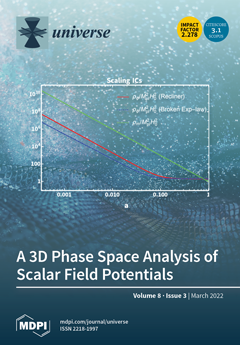Dependencies of midrapidity
pt distributions of the charged pions and kaons, protons and antiprotons on charged-particle multiplicity density (<
dNch/
dη>) in inelastic proton-proton collisions at (
s)
1/2 = 7 TeV at the LHC, measured by ALICE
[...] Read more.
Dependencies of midrapidity
pt distributions of the charged pions and kaons, protons and antiprotons on charged-particle multiplicity density (<
dNch/
dη>) in inelastic proton-proton collisions at (
s)
1/2 = 7 TeV at the LHC, measured by ALICE Collaboration, are investigated. The simultaneous minimum
χ2 fits with the Tsallis function with thermodynamical consistence and the Hagedorn function with included transverse flow have well-described the
pt spectra of the particle species in the ten studied groups of charged-particle multiplicity density. The effective temperatures,
T, of the Tsallis function with thermodynamical consistence have shown a steady rise with increasing the charged-particle multiplicity in proton-proton collisions at (
s)
1/2 = 7 TeV, in agreement with the similar result obtained recently in proton-proton collisions at (
s)
1/2 = 13 TeV at the LHC. The respective
T versus <
dNch/
dη> dependence in proton-proton collisions at (
s)
1/2 = 7 TeV is reproduced quite well by the simple power function with the same value (≈ 1/3) of the exponent parameter as that extracted in proton-proton collisions at (
s)
1/2 = 13 TeV. The identical power dependence
between the initial energy density and effective temperature of the system has been observed in proton-proton collisions at (
s)
1/2 = 7 and 13 TeV. We have observed that the transverse radial flow emerges at <
dNch/
dη> ≈ 6 and then increases, becoming substantial at larger multiplicity events in proton-proton collisions at (
s)
1/2 = 7 TeV. We have estimated, analyzing
T0 and
versus <
dNch/
dη> dependencies, that the possible onset of deconfinement phase transition in proton-proton collisions at (
s)
1/2 = 7 TeV occurs at <
dNch/
dη> ≈ 6.1 ± 0.3, which is close to the corresponding recent estimate (<
dNch/
dη> ≈ 7.1 ± 0.2) in proton-proton collisions at (
s)
1/2 = 13 TeV. The corresponding critical energy densities for probable onset of deconfinement phase transition in proton-proton collisions at (
s)
1/2 = 7 and 13 TeV at the LHC have been estimated to be 0.67 ± 0.03 and 0.76 ± 0.02 GeV/fm
3, respectively.
Full article





